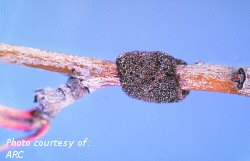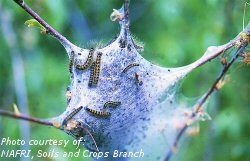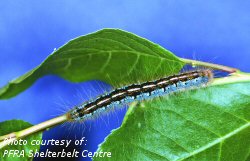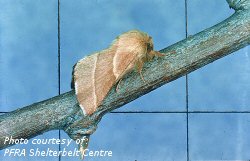Tent Caterpillars (Malacasoma Californicum Lutescens and Malacasoma Americanum)

Forest tent caterpillar egg mass

Tent caterpillar nest with larvae

Prairie tent caterpillar larva

Prairie tent caterpillar adult
Host Plants And Distribution
The prairie tent caterpillar (M. c. lutescens) and the eastern tent caterpillar (M. americanum) will feed on chokecherry, pin cherry, saskatoon, currant, willow and occasionally on other hardwood species. The prairie tent caterpillar is found across western Canada and bordering states. The eastern tent caterpillar is primarily found in southern Manitoba and Saskatchewan.
Biology
The life cycle of the tent caterpillars is very similar. Both have one generation per year and overwinter as eggs that are laid in clusters on twigs within 30 cm of the ground. Eggs hatch in spring at the same time as the first flush of leaves. Larvae construct nests near a fork in the stem. Unlike the ugly nest caterpillar and the fall webworm, they do not feed in the nest. Instead, they forage out from the nest in search of foliage to feed on. They return to the nest to rest or during inclement weather. New nests may be constructed on neighboring plants if the food supply on the original host is exhausted. The prairie tent caterpillar is black with a white stripe in the centre of the back and pale blue sides. The eastern tent caterpillar is also black but has broken orange stripes along the side with white and blue markings. Larvae are sparsely hairy and feed for 6 to 8 weeks. When feeding is completed, cocoons are formed and the moth will emerge about three weeks later. Adults are stout-bodied moths and vary from chocolate brown to buff in colour, with two oblique whitish bands across the front wings.
Symptoms And Damage
Temporary disfiguration of plantings may occur and loss of production from affected hosts may occur. Little permanent damage is likely to be caused.
Scouting Techniques
Nests are very obvious and easily located by visual inspection. Checking the orchard weekly for developing nests should allow for early detection.
Economic Thresholds
No economic thresholds have been established for this insect. Treatment of nests is the same as that for other nest- forming caterpillars. Infestations can be controlled by pruning and destroying nests.
